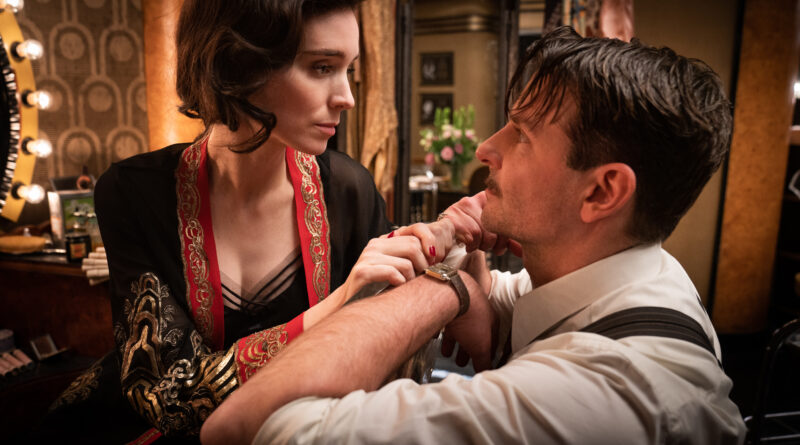A trip down Nightmare Alley with Bradley Cooper
When charismatic but down-on-his-luck Stanton Carlisle (Bradley Cooper) endears himself to
clairvoyant Zeena (Toni Collette) and her has-been mentalist husband Pete (David Strathairn) at a travelling carnival, he crafts a golden ticket to success, using this newly acquired knowledge to grift the wealthy elite of 1940s New York Society.
With the virtuous Molly (Rooney Mara) loyally by his side, Stanton plots to con a dangerous tycoon (Richard Jenkins) with the aid of a mysterious psychiatrist (Cate Blanchett) who might be his most formidable opponent yet.
The film stars Bradley Cooper, Cate Blanchett, Toni Collette, Willem Dafoe, Richard Jenkins, Rooney Mara, Ron Perlman, Mary Steenburgen, David Strathairn.
Director, Guillermo del Toro, said: “I was very interested in a story about destiny and humanity. Stanton Carlisle is a man who is given all the elements to change his life. He has people who believe in him, who love him and trust him. Yet his drive and his own hubris are so strong that they turn him away from that.”
With Nightmare Alley, visionary storyteller Guillermo del Toro journeys into the most arrestingly dark, sweeping and realistic world – the cinematic world of film noir. The film moves from the inner circle of a 1930s travelling carnival, a realm of shocks and wonders, to the halls of wealth and power where seduction and treachery reside.
At its core lies a man who sells his soul to the art of the con. This is Stanton Carlisle (Bradley Cooper), a drifting hustler who transforms himself into a dazzling showman and manipulator so masterful he comes to believe he can outwit fate.
As Stanton makes his delirious rise, del Toro tracks a reckless American Dream running off the rails.
Del Toro’s film is based on William Lindsay Gresham’s fatalistic novel published in 1946 about a
charismatic huckster consumed by uncontrolled ambition.
Naturally drawn to the macabre and profoundly human world of carnival sideshows, del Toro saw Gresham’s novel as autobiographical and wanted to explore the murky lines between illusion and reality, desperation and control, success, and tragedy.
He saw it as a cautionary tale about the dark side of American capitalism. Del Toro reteams with master craftspeople cinematographer Dan Laustsen, production designer Tamara Deverell, costume designer Luis Sequeira and editor Cameron McLauchlin for Nightmare Alley.
With sharper edges than any movie he’s made, the film is a true hardboiled tale of crime, betrayal, and scathing comeuppance. Even within its dusky contours, it retains a mythic quality and probing humanity that define such del Toro classics as Pan’s Labyrinth and The Shape of Water.
Del Toro says he very consciously wanted to stretch his filmmaking in new directions. “This is the
first of my movies that, although it has a magical atmosphere, is not mannered or stylised. It’s set in a reality that is identifiable and immediate,” he added.
“Nightmare Alley departs from the fantastical elements Guillermo is known for creating,” enthused del Toro’s frequent collaborator, producer J. Miles Dale. “But he brings to this new territory all his storytelling skills and design prowess. Ultimately, he tells the story of a man hoisted onto his own karma. One of the film’s most powerful themes is that no man can outrun himself.”
Within Nighmare Alley, there are seething layers of corruption, vice, lust, betrayal, and cosmic absurdity that build as Stanton learns to cynically prey on the human need to believe in something outside themselves and our world. Del Toro avoids the trademark visual aspects of noir, keeping the story speeding forwards, as Stanton’s life becomes a harrowing circle.
del Toro added: “I wanted to render a classic story in a very alive and contemporary way. I wanted people to feel they are watching a story pertinent to our world.”
Indeed, in its visceral realism, the film takes on the urgency of a moral fable—a of fate’s bill
coming due, structured to end with a bang. “When an audience is invested in the story of a person’s rise, their greatest fear is the fall and that fall can be very emotionally strong,” says del Toro.
Cate Blanchett, who brings a mix of strength and smoldering heat as the film’s reverse femme fatale — the brilliant, avenging psychoanalyst Dr. Lilith Ritter — was drawn to those emotions.
She sees the story as a cautionary tale, one as class conscious as it is attuned to psychological demons, and one very much about how contempt and dread can obliterate all, even love.
“Nightmare Alley is about fear, about greed, and it’s about manipulation. It has all the dark
underpinnings of what seems to be a very polite society. The world of the carnival might have some trickery and deceit, but it has the beating heart of a true community. It is the high society in this film that is far more threatening and terrifying,” added Blanchett.
The ambitious shoot began in early 2020 with an all-star ensemble led by Cooper, Blanchett, Toni
Collette, Willem Dafoe, Richard Jenkins, Rooney Mara, Ron Perlman, Mary Steenburgen, and David
Strathairn.
In March that year, the global pandemic shut down production and the outside world took its
own unsettling turn. Amid mounting concerns, del Toro, Dale and Cooper met, called the studio and when
they came back to the set that evening, announced to the crew that the were stopping at that very moment.
“We had no idea how long we would be gone days, weeks or months, but for safety’s sake we had to stop.”
Commitment to the film was firm. “All the sets, set decor, props and lights remained in that dark studio for almost exactly six months, until we resumed in mid-September,” said producer Dale.
“The carnival, which had already been mostly built, spent the spring and summer ageing authentically in the sun and the rain. We picked up exactly where we left off.”
During that time, del Toro felt the swooping arc of Stanton Carlisle’s trip towards the abyss with
even more clarity. “During the hiatus, the project actually became much more deeply ingrained in us, and
we were able to analyse the characters and begin the editing process,” he said.




